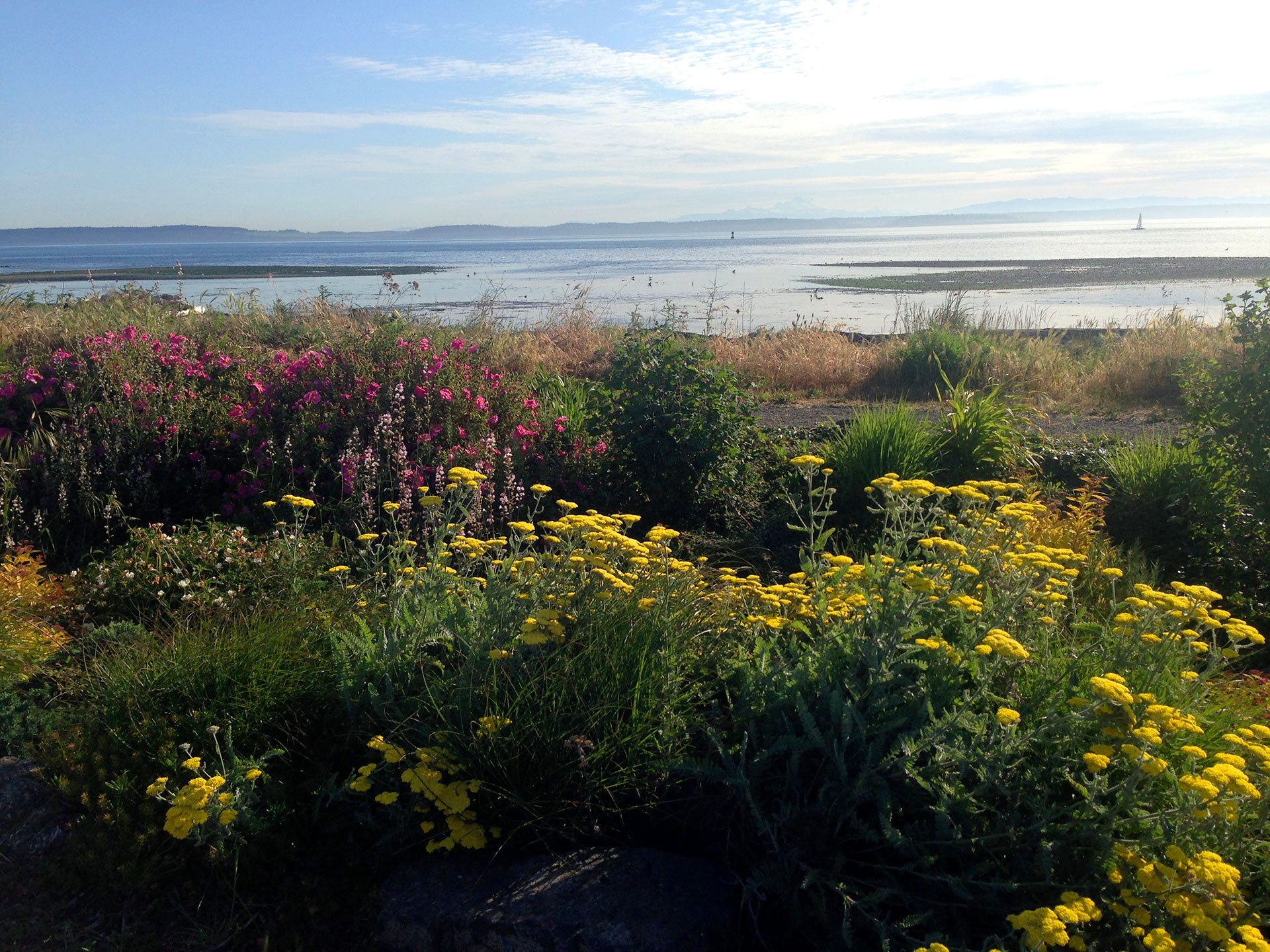
Creating a Be-Mushroomed Rain Garden
April showers bring May flowers and encourage delicious Morel and Oyster mushrooms. Rain freshens the air and bathes the roots of budding plants, piercing the drought of early spring. Watching the showers pour from our rooftops, over driveways and down streets also reminds us of a bright opportunity to enhance our landscapes and reduce water pollution: planting beautiful Rain Gardens.
When water flows over impervious surfaces on our property and in our communities, it picks up debris, fertilizer and pesticide residues, automotive fluids, and other toxic chemicals. In many cities the stormwater is not treated, so all these pollutants can be swept right into our waterways. In Washington State—home of Fungi Perfecti—polluted stormwater is the number one toxic threat to the Puget Sound (Puget Sound Keeper).
Rain Gardens are attractive and functional landscape features that double as an effective mode of decentralized stormwater management. These gardens mimic the function of a native landscape by slowing the flow of water; allowing water to penetrate the ground, get filtered by the soil, transpired back into the air by plants, and ultimately cleansed of pollutants before it reaches streams and other bodies of water.
There are several key components to a successful Rain Garden, which are further detailed in the Rain Garden Handbook and resources at the bottom of this article:
- Ponding area: A rain garden is formed as a depression in the ground, which can fill partway during storm events, preventing polluted water from flowing freely to sensitive bodies of water.
-
Soil: A rain garden must have deep soil to support the growth of plants, and filter water. It also provides a home for soil-dwelling microbes which are integral to the breakdown of many pollutants.
Plants: Selecting the right plants for a rain garden is essential! Drought-tolerant plants should be selected to reduce the need of supplemental maintenance. Plants at the bottom of the rain garden should be able to tolerate occasional standing water. Selecting plants of varying root types will enhance transpiration of water through the rain garden and improve soil stability. - Be sure to make your garden BEE FRIENDLY by using native and pollinator-friendly plants. The Pollinator Partnership has planting guides by ecoregion, to help you select bee-friendly plants. We encourage you to explore our research into the importance of mushrooms for bees in our Bee-Friendly Research Update.
- Mulch: It has been shown that mulch enhances water infiltration and retention. Furthermore, the greater surface area helps bind pollutants and provides habitat for contaminant-degrading fungal decomposers. By spreading mulch, preferably hardwood chips or straw, and inoculating with a terrestrial mushroom, you can turn your mulch into a “Mycofilter”!
In the 1970's, Paul Stamets was working closely with mycelium at the Evergreen State College. In his book Mycelium Running, Paul describes inspecting the fungi through a scanning electron microscope, imagining “that this fabric of fine cells could act as a biological filter... growing through the environment, filtering water after it rains." The idea of “Mycofiltration” was born.
The article Mycofiltration Enters the Commons delves deeper into the potential uses of these mycelial membranes for filtering out microorganisms, pollutants, and silt. It also summarizes our research results and further resources for you to explore.

| A standard rain garden can be greatly enhanced with the addition of beds of King Stropharia mushrooms. Stormwater runoff from gutters, driveways and other impervious surfaces drains into your rain garden. Layers of mulch boost water infiltration/retention and provide a medium for fungi and other beneficial organisms. A deep well of soil provides an anchor for plants and hosts a wide variety of beneficial microbes. King Stropharia mushrooms form dense mycelial mats, stabilizing soil and helping to filter stormwater runoff. (Diagram by Chase Slaker) |
Here are some strategies to “fungi-fy” the functionality of your Rain Garden:
-
Mycelium for Mycofiltration – When you inoculate your rain garden with the terrestrial Stropharia rugoso-annulataor Garden Giant, it will act as a garden companion, transforming organic materials into nutrients available to your plants, and improving soil structure.
Planning Guidelines: Coarse hardwood chips (smaller than 4”) are preferred, without excessive leaves, bark and debris, though the Garden Giant can grow well on a mix of up to 50% conifer wood chips. Fresh wood chips are best, as they contain fewer competitors. Straw may also be utilized as a substrate, or as a loose layer on top. The Garden Giant Mushroom Patch™ comes with detailed instructions on setup and care, and can inoculate enough woodchips to cover 20 square feet.
- Inoculate plants with Mycorrhizal fungi - Mycorrhizal fungi are known to increase the plant's ability to utilize water and nutrients in the soil, as well as their ability to cope with environmental stress. Both saprophytic fungi and mycorrhizal fungi help to degrade a wide variety of pollutants in the soil, in addition to enhancing filtration and reducing erosion!
Planning Guidelines: Keep in mind, mycorrhizae rely upon their plant partners, and therefore should not be added to the soil long before plants are there. You can treat plant roots with mycorrhizal inoculum prior to planting, or water the mycorrhizae into the root zone of plants already in the ground. The sooner you can introduce mycorrhizae after planting, the better!
A list of plants and the types of mycorrhizae they associate with can be found online: Mycorrhizae-Compatible Plants. Our most comprehensive product is MycoGrow Soluble.
Useful Resources:
https://www.nativeplantsalvage.org/rain-garden
The Rain Garden Handbook for Western Washington
http://www.12000raingardens.org/about-rain-gardens/benefits/
Permaculture with a Mycological Twist
Helping the Ecosystem through Mushroom Cultivation
